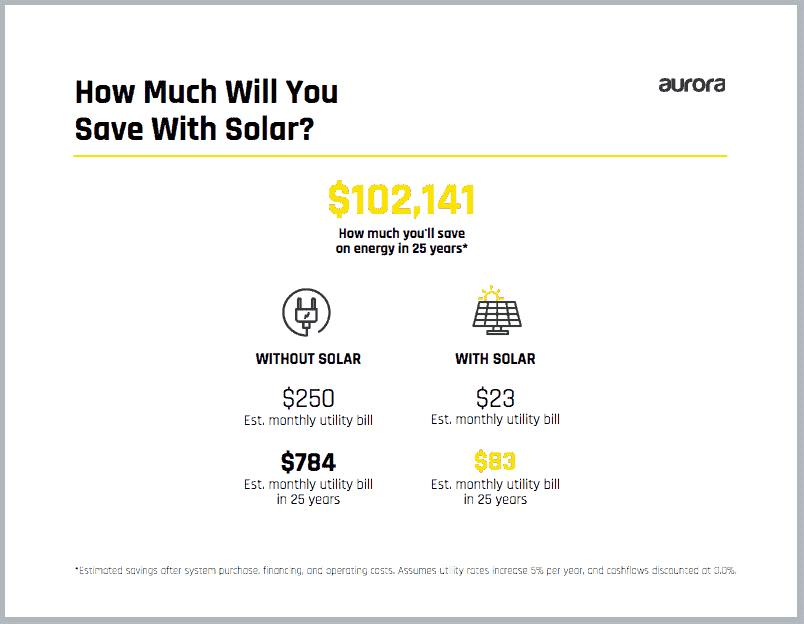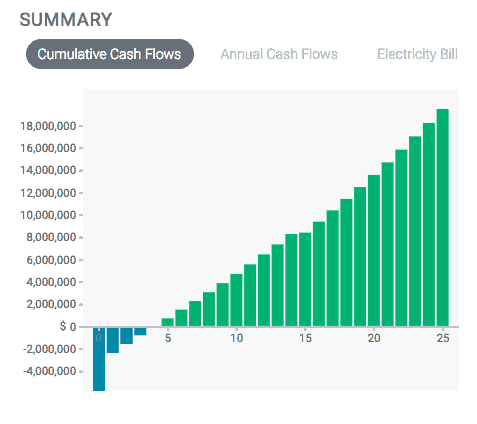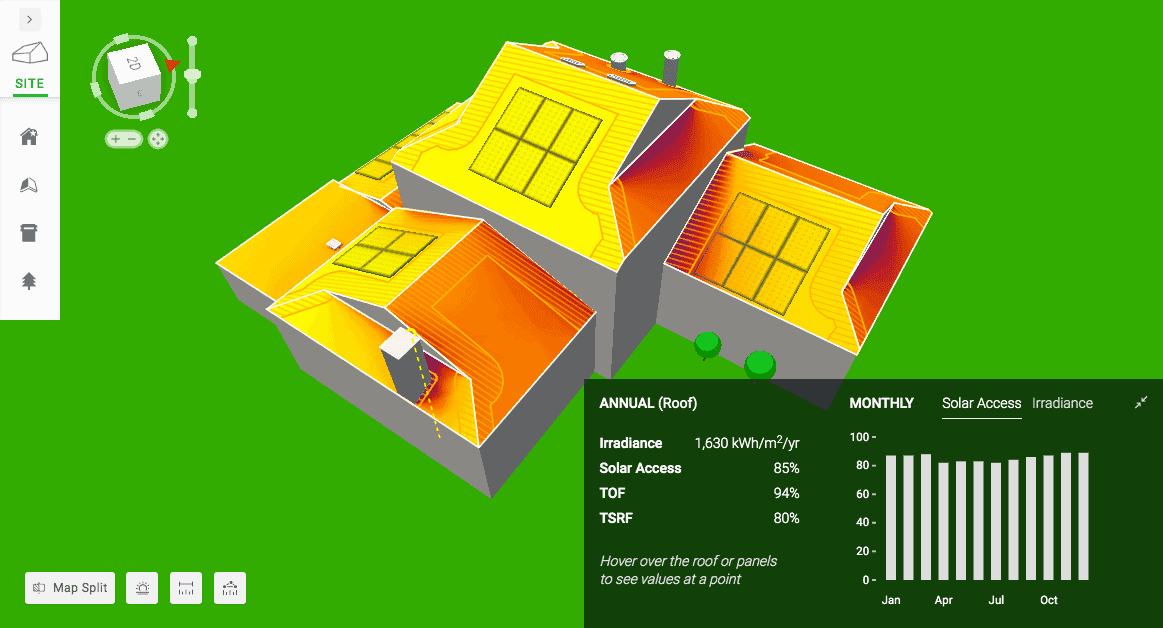Residential solar customer acquisition can be an expensive process. In 2017 GTM estimated that the average cost of getting new solar customers was 17% of the total residential system cost and set to grow to 20%. Therefore, making your sales and marketing process as effective and targeted as possible is important.
There are many factors that influence consumer behavior. The more you understand the various factors at play when a prospect considers adopting solar, the better equipped you are to speak to their specific concerns and present them with the most engaging information.
NREL funded a study to shed light on the social and psychological factors influencing homeowners when they consider solar PV. This second article in our three-part series on this study looks at some of its findings and how they can support your solar sales and marketing process.

This Series and the NREL Study
In this Aurora blog series, we examine the insights of a 2016 NREL-funded study, Explaining interest in adopting residential solar photovoltaic systems in the United States: Toward an integration of behavioral theories.
Researchers from several universities surveyed 904 homeowners from four U.S. states who had not already adopted solar to understand the impact of certain psychological and social factors on consumer interest in residential solar. These factors were selected based on three behavioral theories that offer insights about prospects’ decision making processes, as well as input from professionals in the solar industry.
Each article in our series looks at one of the behavioral theories included in the study, examining insights it offers for the solar customer acquisition process. Where applicable we also pull in other related research.
In this article, we consider what the “theory of planned behavior” has to reveal about the adoption of solar as a consumer good. In the first article, we looked at insights from a theory viewing solar as a new innovation and in the final article, we’ll highlight findings from a theory related to environmentalism.
The Theory of Planned Behavior
The theory of planned behavior (TPB) asserts that the intention to perform a behavior comes from a rational decision making process involving the consideration of three things:
1) one’s attitudes toward the behavior,
2) subjective norms or one’s perceived social pressure to engage in the behavior, and
3) perceived behavioral control (perception of one’s ability to perform that behavior).
According to TPB, during the purchasing process, all three of these factors are impacted by the value a consumer expects to gain from the purchase and their beliefs about the purchase’s consequences. As applied to residential solar, this might be the fact that a solar system is a relatively expensive consumer good that requires some significant alterations to their home. Therefore, the solar decision making process can be partially explained by the weighing costs and benefits, such as the impact on one’s home and finances.
TPB Factors and What They Mean for Contractors
The study found a number of TPB variables related to consumer beliefs that influence attitudes toward residential solar. The researchers found that these factors accounted for 29% of the variation in interest in solar adoption, after accounting for other household constraints.
Understanding how these variables impact the prospect’s decision making process can offer valuable insights to improve your marketing materials and sales conversations with homeowners.
Inform Consumers About the Feasibility of Solar
Strategically counteracting negative perceptions about solar can help increase solar sales success. Prevalent positive ideas about the benefits of solar were found to include: belief in solar’s ability to protect against rising electricity costs, improvement in home value, and reductions in environmental pollution. The perception that had the strongest direct effect on those considering solar was the belief that they would personally benefit, followed by the idea that it could address environmental problems.
However, drawbacks that could potentially interfere with these perceptions about solar’s benefits were misconceptions about maintenance costs, unreliability, and the risks involved with altering one’s house. Researchers found that a particular barrier was worry about the price of the installation and maintenance, particularly given that solar’s price and operating costs are generally less well-known when compared to other large consumer purchases like cars or appliances.
There was also the common idea that, given fears about potential risks, it was better to wait until the quality and cost-effectiveness of solar improved, particularly since some prospects knew that panel costs had been going down in recent years. It may be important to clarify solar’s current—and potentially quite affordable—installation and maintenance costs since many prospects simply don’t have information about them.

A 2015 Texas study using TPB to examine prospect decision making found a “low awareness of solar costs” among respondents. The researchers found that many said they would install solar if they could afford it and felt there would be only low financial returns, despite the existence of federal and local incentives and leasing options.
In light of this, researchers suggested that solar companies work to educate consumers about solar by making them more aware of incentives like rebates, declining prices, and lease options. They also advised that education about incentives is more effective if it includes information that clearly enables prospects to assess how incentives actually impact key criteria like affordability. Therefore, it may be effective to not only educate about the typical price of installation and maintenance but also present information about incentives in a way that is particularly attractive and relevant to a prospect’s particular set of criteria.
Aurora’s financial analysis tools can be particularly helpful here—because you can model the cost of the customer’s system given any applicable incentives. You can also how financial metrics and cash flows differ under different financing options.

Create Positive Social Pressure: Connect Prospects with Neighbors Who Have Gone Solar
Find opportunities to encourage interactions between homeowners considering solar and others in their area who are happy solar customers. The study found that a belief in peer support (or lack of it) was the second most impactful variable when it came to solar adoption. This is based on the idea that a large number of prospects view group approval or disapproval as important. Researchers found that the feeling that friends and neighbors supported solar adoption often counteracted their concerns about the perceived risks.
Peer-to-peer marketing is one way you can encourage sharing about the benefits of solar. Inc.com states that “as a marketing decision…getting some early adaptors to tell their friends is more efficient and more effective than just about anything else you can do.”
If your company has successfully installed the first system in a particular neighborhood, you may look to capitalize on this through localized marketing efforts. Some of our team members who have previously sold solar for leading installation companies suggest that one way to do this is to use Aurora to create custom solar designs for neighboring houses, and distribute them on the day of the install. Securing positive online reviews, requesting referrals, or creating high quality, engaging content that is easily shareable in person or online.

Help Prospects Feel They Can Go Solar By Addressing Their Concerns
The results of the study showed that even peer influence can be overridden by a homeowner’s belief that they are not able to adopt solar. Given this, it is helpful to explicitly identify a prospect’s concerns and address them in the sales conversation.
Typical reasons customers believe solar is not feasible for them were found to be: concerns about local climate, exposure to sunlight on their property, and expectations about having to move soon.
Concerns About Shade
The study stated that “homeowners may quickly dismiss [residential PV] if they believe their homes or locations unsuitable” because of things like inadequate sunlight due to the local climate or the shadiness of their property.
Interestingly, however, researchers found that this particular concern made a prospect more likely to want to talk to a contractor, reflecting a genuine interest in confirming whether their property was truly unsuitable for solar.
This is something you may wish to use to shape your initial messaging or early stages of sales conversations. Aurora users can also take advantage of the irradiance map feature, which helps you show a prospect how much shade and solar access a home has, to address these concerns.

Concerns About Moving
Another common concern brought up by prospects was that “I may not be in my home long enough to get the benefits of investing in solar.” You may consider addressing this by offering information about solar’s impact on their home’s value during your sales conversations.
There are a number of studies that demonstrate that U.S. houses with solar sell faster and for more money. A 2015 Lawrence Berkeley National Lab study examined sales data for 23,000 homes in eight states from 2002 to 2013, 4,000 of which had a solar system. The study found that buyers were willing to pay a premium of $15,000 for a home with an average-sized solar PV system, compared to a similar home without one.
You can leverage these social and psychological factors that shape prospects’ perceptions about solar and its suitability to effectively target your solar sales and marketing efforts. These findings based on the theory of planned behavior highlight how to engage homeowners and address their specific concerns. In the next and final article of this series, we’ll look at findings from a behavioral theory related to environmentalism and examine how they can assist in the solar customer acquisition process.
About This Series: Solar Sales Tips from 3 Theories of Solar Adoption
In 2016 the National Renewable Energy Laboratory (NREL) conducted a study that examined the decision making process of residential solar prospects through the lens of three behavioral theories. They sought to provide solar industry professionals with insights about the social and psychological factors influencing homeowners when they considered whether or not to adopt PV solar, in order to help increase the solar adoption rate.
In this three-part series, we look at each of these theories and discuss the key variables explored in the study and in related research. The series seeks to provide contractors information that can enhance their sales and marketing efforts.
Part 1. Increase Solar Sales Success with the Diffusion of Innovations Theory
Part 2. Solar Sales Insights from the Theory of Planned Behavior
Part 3. Solar and the Environment: Surprises from the Value-Belief-Norm Theory